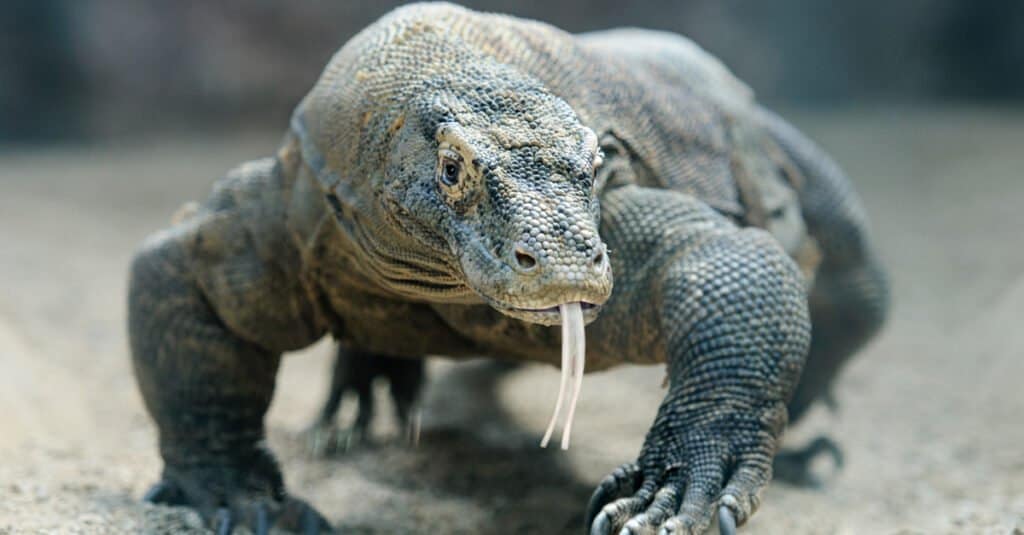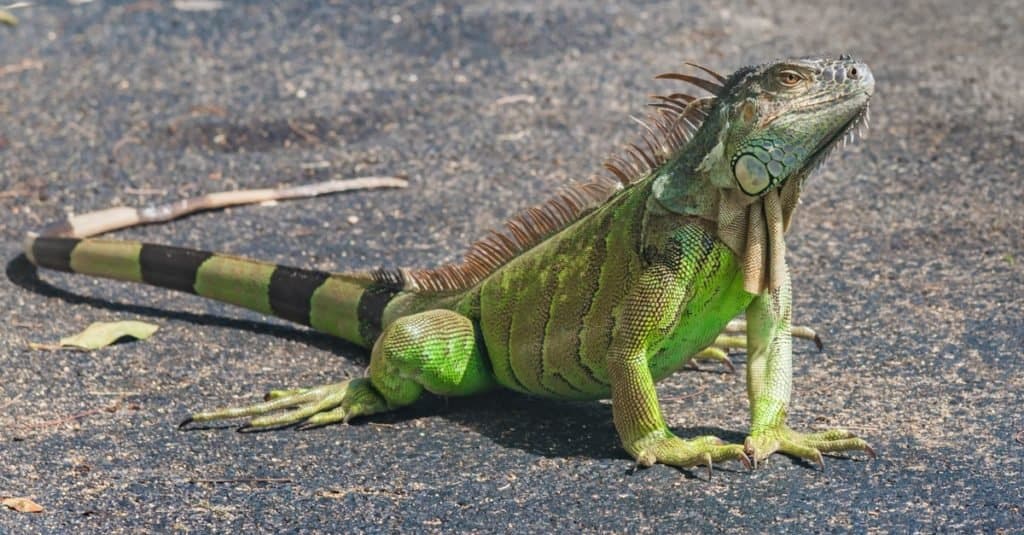
Lizards are one of the most adaptable members of the reptile family. You can find them on every continent except Antarctica, and in varied habitats from forests to deserts. They range in size from giant Komodo dragons to tiny geckos that can fit in your hand. Over millions of years, lizards evolved a host of techniques to hunt prey and avoid predators. If you’ve ever owned a pet lizard, then you likely already know that most lizards eat a carnivorous diet. Given that lizards range widely in size, it stands to reason that they also eat a wide assortment of prey. That said, do you know the answer to the question “what do lizards eat?”
Today, we’ll explore what foods lizards like to eat over others, as well as how they hunt for food. In addition, we’ll discuss what lizards eat in the wild, versus what pet lizards eat. Finally, we’ll take the time to examine how the diet of baby lizards differs from the diet of adult lizards. So, get ready to walk on the wild side, as we discover what lizards eat.
What Do Lizards Like to Eat?

Lizards can be insectivores, omnivores, carnivores, or herbivores.
©Przemyslaw Skibinski/Shutterstock.com
Contrary to popular belief, not all lizards eat a carnivorous diet. While many lizards classify as carnivores, an equally large percentage rank as insectivores. This means that they predominantly eat insects and small invertebrates. However, a small percentage of lizards eat an herbivorous or omnivorous diet. Given all these differences, it’s important to avoid generalizations when explaining what lizards like to eat. That said, a few general patterns emerge across the diets of lizards. These foods frequently appear on the lists of foods that lizards eat. Using these foods as a benchmark, we’ve narrowed it down to 15 foods that most lizards like to eat.
The most common foods that appear in a lizard’s diet include:
- Insects
- Invertebrates
- Eggs
- Small mammals
- Leaves
- Berries
- Grasses
- Fruits
- Birds
- Fish
- Rodents
- Vegetables
- Small amphibians
- Fruit
- Other reptiles
Due to size restrictions, most lizards eat animals smaller than them. However, some exceptionally large lizards will eat larger prey, including medium and large-sized mammals. In addition, many carnivorous and omnivorous lizards will eat carrion in the wild.
How Do Lizards Hunt and Forage For Food?

Komodo dragons use their powerful venom to take down large prey.
©Anna Kucherova/Shutterstock.com
The first lizards emerged more than 300 million years ago. During the following millennia, lizards evolved numerous techniques to help them hunt and forage for food. Common adaptations include camouflage, venom, and long tongues designed to catch prey. Most lizards use sit-and-wait tactics when hunting prey. Lizards who use this technique wait for prey to wander too close before ambushing their unsuspecting victim. Some lizards, like chameleons, will remain completely still, and then shoot out their long, sticky tongue to catch insects. Meanwhile, other lizards take a more active approach when hunting and foraging. These lizards will target ant and termite hills or climb trees to get at birds or their eggs. Others will ambush prey and deliver a venomous bite, and then wait for their food to weaken from the toxins before moving in for the kill.
Lizards use sight, touch, smell, and hearing to detect prey and forage for food. Depending on their biology and habitat, some lizards rely on certain senses over others. All lizards can detect pheromones using their vomeronasal organ, which helps them to smell prey. Although they lack external ears, lizards still possess eardrums which they use to hear for predators and prey. Some lizards, like chameleons, can individually manipulate their eyes to look in different directions. With this skill, they can even look forward and backward at the same time. Other lizards, like the gecko, also rely on their acute vision to help them find tiny insects. Meanwhile, some skinks will bury themselves in the ground and rely on smell and touch to detect prey.
What Do Lizards Eat in the Wild?

Green iguanas are one of the few herbivorous lizards.
©David A Litman/Shutterstock.com
The food that lizards eat varies according to their biology and habitat. In addition, lizards that live in temperate climates adjust their diet according to the seasons. Lizards are ectotherms, and therefore require external heat in order to stay warm. Lizards that live in climates with cold winters go dormant. During this time, their body uses less energy, and they don’t require as much – or any – food to survive.
Most pet lizards and smaller lizards are either insectivores or omnivores. Insectivorous lizards include several species of gecko and anole. For example, house geckos, African fat-tailed geckos, and leopard geckos eat only insects. On the other hand, crested geckos and day geckos also eat some fruit in their diet. Common insects consumed by insectivorous lizards include flies, crickets, grasshoppers, ants, termites, and moths. They will also eat invertebrates like snails and slugs. Examples of omnivorous lizards include bearded dragons, blue tongued skinks, and plated lizards. These lizards eat a wide variety of plant and animal matter. In the wild they’ll eat bird eggs, beetles, leaves, fruits, flowers, and some small rodents or even other lizards.
A smaller percentage of lizards eat a purely carnivorous or – even rarer – herbivorous diet. Carnivorous lizards eat a wide variety of animals, including insects, mollusks, crabs, fish, frogs, rats, mice, and birds. Some large lizards, like Komodo dragons, target large mammals like deer, water buffalo, goats, and pigs. Other lizards, like the collared lizard, specialized in eating other small lizards as the main part of their diet. On the other hand, herbivorous lizards do not eat any meat and consume only plant matter. For example, the green iguana is a strict herbivore, although it will eat some insects. In the wild, they consume flowers, plant shoots, fruits, and leaves.
What Do Pet Lizards Eat?

Certain fruits, plants, and insects can prove dangerous to your pet lizard’s health.
©Edy Pamungkas/Shutterstock.com
Your pet lizard’s diet will vary according to its species. To make sure you buy the right food for your pet lizard, consult your local pet store expert or veterinarian. For omnivorous, insectivorous, and carnivorous lizards, your local pet store likely sells specialized packaged feed mixes. These mixes may contain a mixture of vegetables and insects, or purely insects such as mealworms, crickets, or flies. That said, some pet lizards don’t thrive on packaged foods, and should only eat live prey or fresh plants. If you own a larger carnivorous pet lizard, you will need to include more protein in its diet. You can accomplish this with live or frozen rodents. Be advised, your pet lizard may not have the skills it needs to tackle larger live prey. To ensure its safety, monitor its feeding to ensure it’s not hurt by animals introduced as food.
As for herbivorous pet lizards, they do well on a mixture of nutritious vegetables, fruits, leaves, and flowers. Safer options for your herbivorous pet lizard include:
- Apples
- Bananas
- Grapes
- Melon
- Berries
- Pears
- Figs
- Dandelion
- Carrots
- Tomatoes
- Dark leafy greens
- Alfalfa
- Green peas
- Squash
So long as your pet lizard eats foods within its food family, it should be relatively healthy. However, keep in mind that certain foods can prove toxic or harmful to your pet lizard even if they are within its food family. For example, some insects can harm your pet lizard, while certain plants and fruits can reduce their nutrient intake. A few insects and plants that you should avoid feeding your pet lizard include:
- Fireflies
- Scorpions
- Centipedes
- Ticks
- Broccoli
- Cabbage
- Lettuce
- Chocolate
- Grains
- Avocado
- Garlic
- Onion
- Nuts
- Seeds
What Do Baby Lizards Eat?

Baby lizards eat the same foods as adult lizards, but have size limitations.
©lessysebastian/Shutterstock.com
It’s essential that baby lizards get plenty of nutrients to help them grow and develop. From the moment they hatch, baby lizards can eat most of the same foods their parents eat. That means that a carnivorous baby lizard will eat a carnivorous diet, while a herbivorous baby lizard will eat a herbivorous diet. In the wild, their diet is purely limited to what food they can catch and fit in their mouths. Due to size limitations, many baby lizards cannot eat smaller mammals, fish, amphibians, or larger mammals. As a result, they will mostly target insects or eat plant matter, if they aren’t carnivorous or insectivorous.
Before feeding your baby lizard, consult an expert to ensure you’re providing your pet lizard with the right foods. Common prey includes ants, crickets, grasshoppers, flies, and spiders. Like adults, some species do better with live prey, so make sure to consult an expert. You can buy numerous pellet and packaged baby lizard foods from your local pet store. However, certain pet lizards do better on live prey. In general, insects like fruit flies, crickets, and mealworms make for great baby lizard food. Meanwhile, healthy food for a baby herbivorous lizard includes fresh fruit and vegetables. Common foods include cucumbers, green beans, flowers, leafy greens, squash, celery, apples, pears, melon, and berries.
The photo featured at the top of this post is © bumihills/Shutterstock.com
Thank you for reading! Have some feedback for us? Contact the AZ Animals editorial team.






